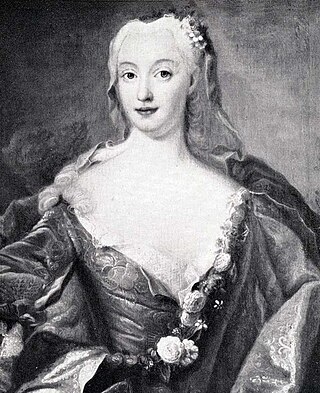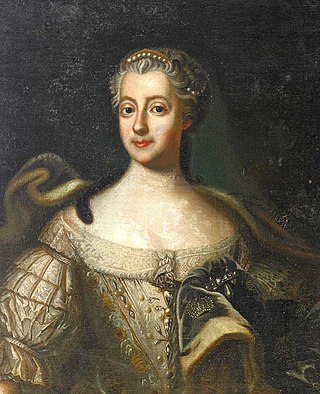
Charles XIII, or Carl XIII, was King of Sweden from 1809 and King of Norway from 1814 to his death. He was the second son of King Adolf Frederick of Sweden and Louisa Ulrika of Prussia, sister of Frederick the Great.

Adolf Frederick, or Adolph Frederick was King of Sweden from 1751 until his death in 1771. He was the son of Christian August of Holstein-Gottorp, Prince of Eutin, and Albertina Frederica of Baden-Durlach. He was an uncle of Catherine the Great and husband to Louisa Ulrika of Prussia.

Ulrika Eleonora or Ulrica Eleanor, known as Ulrika Eleonora the Younger, reigned as Queen of Sweden from 5 December 1718 until her abdication on 29 February 1720 in favour of her husband Frederick. Following her husband's accession as King Frederick I, Ulrika Eleonora served as his queen consort until her death in 1741.

The monarchy of Sweden is centred on the monarchical head of state of Sweden, by law a constitutional and hereditary monarchy with a parliamentary system. There have been kings in what now is the Kingdom of Sweden for more than a millennium. Originally an elective monarchy, it became a hereditary monarchy in the 16th century during the reign of Gustav Vasa, though virtually all monarchs before that belonged to a limited and small number of political families which are considered to be the royal dynasties of Sweden.

The Council of the Realm, or simply The Council, was a cabinet of medieval origin, consisting of magnates which advised, and at times co-ruled with, the King of Sweden.

The 1809 Instrument of Government, adopted on 6 June 1809 by the Riksdag of the Estates and King Charles XIII, was the constitution of the Kingdom of Sweden from 1809 to the end of 1974. It came about as a result of the Coup of 1809, in which King Gustav IV Adolf was deposed. The promulgation of the constitution marks the point at which Sweden transitioned from the absolute monarchy of the Gustavian era into a stable, constitutional monarchy adhering to the rule of law and significant civil liberties.

In Swedish and Finnish history, the Age of Liberty was a period that saw parliamentary governance, increasing civil rights, and the decline of the Swedish Empire that began with the adoption of the Instrument of Government in 1719 and ended with Gustav III's self-coup in 1772. This shift of power from the monarch to parliament was a direct effect of the Great Northern War.

The history of Sweden from 1772 to 1809 is better known as the Gustavian era of Kings Gustav III and Gustav IV, as well as the reign of King Charles XIII of Sweden.

Hedvig Ulrika Taube, also Countess von Hessenstein, was a Swedish courtier and countess, a countess of the Holy Roman Empire, and royal mistress to king Frederick I of Sweden from 1731 to 1744. She is regarded as one of only two official royal mistresses in Swedish history.
The Hats were a Swedish political faction active during the Age of Liberty (1719–1772). Their name derives from the tricorne hat worn by officers and gentlemen. They vied for power with the opposing Caps party. In 18th century Swedish politics, the Hats represented conservatives, the Caps represented liberals. The Hats, who ruled Sweden from 1738 to 1765, advocated an alliance with France and an assertive foreign policy, especially towards Russia. During their tenure, they involved Sweden in two expensive and disastrous wars, in the 1740s and 1750s.

Louisa Ulrika of Prussia was Queen of Sweden from 1751 to 1771 as the wife of King Adolf Frederick. She was queen mother during the reign of King Gustav III.

Sophia Magdalena of Denmark was Queen of Sweden from 1771 to 1792 as the wife of King Gustav III.

Gustav III ,note on dates also called Gustavus III, was King of Sweden from 1771 until his assassination in 1792. He was the eldest son of King Adolf Frederick and Queen Louisa Ulrika of Sweden.

Events from the year 1756 in Sweden

The Coup of 1756 was an attempted coup d'état planned by Queen Louisa Ulrika of Sweden to abolish the rule of the Riksdag of the Estates and reinstate absolute monarchy in Sweden. The attempted coup was exposed and subdued in 1756 shortly before it was due to be put in action. It caused a rift between the royal house and the parliament.

The Revolution of 1772, also known as The Bloodless Revolution or the Coup of Gustav III, was a Swedish coup d'état performed by King Gustav III of Sweden on 19 August 1772 to introduce a division of power between the king and the Riksdag of the Estates, resulting in the end of the Age of Liberty and the introduction of the Swedish Constitution of 1772, which would strengthen the power of the monarch.

The Gustavians were a political faction in the Kingdom of Sweden who supported the absolutist regime of King Gustav III of Sweden, and sought after his assassination in 1792 to uphold his legacy and protect the interests of his descendants of the House of Holstein-Gottorp.

Hovpartiet was the name for a political group in Sweden during the Age of Liberty. Its stated objective was to strengthen the influence and power of the monarchy vice the Riksdag of the Estates. It is most known in history as the force behind Queen Louisa Ulrika's Coup of 1756, but it did in fact exist in some form or another from 1723 until Gustav III's Revolution of 1772, when its unstated objective of reinstating an absolute monarchy was finally realized.

The 1719 Instrument of Government adopted on 21 February 1719 by the Riksdag of the Estates, was the constitution of the Kingdom of Sweden from 1719 to 1720. Although only in force for a few months, it has great significance in Swedish history, as its promulgation marked the end of the country's first period of absolutism (1680-1719) and the beginning of the period of constitutional monarchy and parliamentary government traditionally known as the Age of Liberty.
The Holstein Party, was the name of a political group in 18th-century Sweden which played a significant role in politics after the death of Charles XII of Sweden in 1718 and until 1727.

















